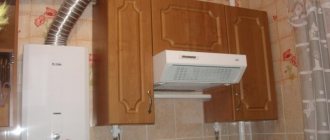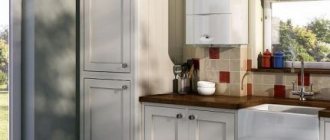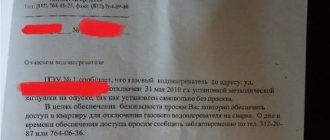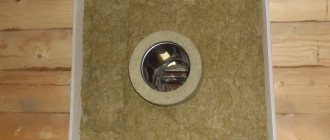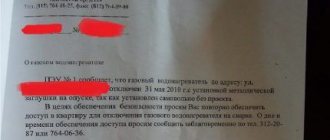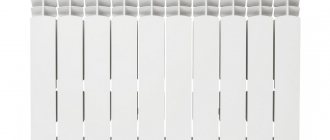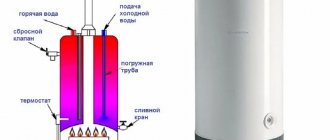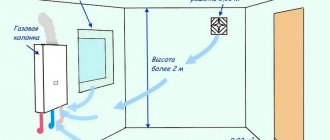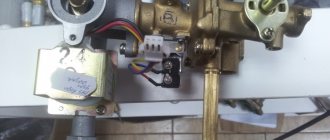Hello, my dear interlocutor.
More than one and a half million people die from carbon monoxide poisoning every year. And in most cases this happens due to faulty geysers or poorly cleaned air ducts.
Do you know what is most dangerous? The gas in cookers is specially “flavoured”. Therefore, our sense of smell can sense a methane leak. With gas in the column, the story is a little different. With poor ventilation, combustion occurs with a lack of oxygen, resulting in the formation of dangerous carbon monoxide, after inhaling which a person loses consciousness and falls asleep. Unfortunately forever.
Therefore, a hood for a geyser is a must-have device. We’ll find out how it works and how to install it correctly from today’s article.
Why does a gas water heater need a hood?
A geyser is a convenient device that allows you to provide residents of your home with hot water at any time of the year. Modern devices are equipped with temperature regulators, sensors for the operation of the water point and other convenient functions. But even the most modern unit will not protect against carbon monoxide if the chimneys in the house are not cleaned.
In addition, household gas is explosive, and if leaked, in a certain proportion with oxygen, it can provoke a disaster.
A hood will help solve the issue of removing combustion products and providing sufficiently high draft. It should be installed strictly in accordance with the requirements of regulatory documents.
The chimney of the column should not be confused with devices for other kitchen appliances that run on gas.
We will consider the advantages of built-in coal hoods for kitchen stoves in one of the following articles.
Installation in a private house
Here, making a chimney design is much simpler due to the fact that the location of the chimney channels can always be designed in the most convenient place for this. There are several rules that are important to follow when installing a chimney in such conditions:
- all horizontal lines of the device must have a slight slope towards the unit;
- when a pipe passes through a stone wall, the cracks that form around it must be sealed with a heat-resistant insulator;
- in the lower part of the vertical outlet you need to build a special hatch for periodic cleaning, and, if necessary, a tap for discharging condensate.
When passing through a wooden partition, the edges of the shaft should be 20 cm away from the surface of the pipe. On the outside and inside of the wall, the product is fixed with metal sheet material (can be galvanized iron), and the voids are filled with an insulator that can withstand high temperatures.
You should know that in a house with wooden floors, the chimney pipe cannot be brought closer to the ceiling at a distance of less than 50 cm.
Installation of a two-layer (sandwich) pipe on the facade is carried out using clamps mounted on brackets. Moreover, the fasteners are not installed at the junction of the elements. The end of the pipe should not rest against a horizontal fragment of the roof, this will reduce the traction force.
Requirements for chimneys for geysers (SNIP)
Requirements for chimneys are set out in the following documents:
- SNiP 41-01-2003 in a new edition (SP 60.13330.2012);
- NPB 252-98 (fire safety standards);
- SP 42-101-2003;
- VDPO (rules for the production of pipe and furnace works).
The main provisions regarding the direct removal of smoke from household water heaters are collected in the following paragraphs:
- The cross-sectional area of the chimney pipe must be greater than or equal to the cross-section of the outlet pipe of the column;
- Laying gas pipes through living rooms is prohibited;
- The chimney system must be completely sealed, resistant to corrosion and temperatures up to 200°C;
- The vertical section of the chimney at the outlet of the column should not be shorter than 500mm. Only in some cases this figure is reduced to 250mm;
- The length of connecting pipes should not be more than 3 m in designed houses and no more than 6 m in existing ones;
- The design allows for no more than 3 turns with a radius of at least the pipe diameter;
- If the wall of the building is made of non-combustible materials, the distance from it to the exhaust pipe must be at least 5 cm, if the wall material is flammable - at least 25 cm. If the fire protection requirements of SP 42-101-2003 are met, the distance can be reduced to 10 cm;
- If the connecting pipe passes through an unheated room, it must be protected with thermal insulation;
- The slope of the exhaust pipe towards the column must be more than 0.01;
- You cannot use one hood for a gas water heater and a gas stove;
- The ceiling height in the room with a water heater and chimney should not be less than 2 m. Area – at least 7.5 m for one device, at least 13.5 for 2 devices.
Artificial ventilation
Additional draft in the exhaust system is created using fans. Their power and number depend on the air load on the channel and the volume of the room.
power is taken from the calculation: maximum load plus a reserve of 25-30%:
max * 1.25, where max is the maximum load;
the number of devices is selected in proportion to the volume of air required for pumping (increase the volume of the room three times):
(h + b + l) * 3, where h is the height of the ceiling, b is the width, l is the length;
the length of the chimney, its geometry and the number of bends are taken into account.
The fan is protected by an installation box. This box is made of non-flammable and stainless materials. Usually copper or aluminum alloys are used.
The design of artificial ventilation is similar to the installation of natural ventilation. After installing the supply pipe, the duct fan is installed. Next, the builders lay the wiring to power the engine, install sensors, a noise absorber and a filter. Just as when installing natural ventilation, grilles are attached to both ends of the pipe. The device for the exhaust pipe is installed in the same way, only taking into account that the air is drawn out and not pumped.
Artificial ventilation requires constant energy costs. Sometimes during construction they save money by installing a fan only for exhaust or only for air supply. However, more efficient circulation is achieved by using both.
The automatic ventilation system allows you to turn off the fans when the boiler is stopped and turn them on when it starts.
Calculation of hood parameters
Before starting work on installing a chimney for a geyser in an apartment or private house, it is necessary to calculate the parameters of the exhaust channel. These parameters determine the required amount of air removed from the room.
When calculating, the following indicators should be taken into account:
- power of heating devices;
- volume of exhaust gases;
- difference in temperatures of outside air and combustion products;
- the height of the chimney pipe (for gas installations at least 2 m).
There are many types of pipelines for geysers, of different diameters, shapes, and lengths. Standard chimney diameters are 110-130 mm. For dispenser power up to 19 kW, a pipe with a diameter of 11 cm is used, above – 13 cm.
What is it and what is it for?
Geysers are devices where water flowing through pipes is heated with an open flame. When natural gas burns, toxic substances are formed that are dangerous to human life.
They must be removed from the room in which the equipment is located. To do this, a chimney pipe is installed that removes waste substances to the outside. In addition, due to the pressure difference, clean air is drawn into the firebox, necessary for continuous combustion.
What kind of corrugation is used for chimneys
Combustion products in an apartment building are discharged into the ventilation duct, in a private apartment - to the street. Depending on where the gases are discharged, the pipes are divided as follows:
- Coaxial - the pipe exits through the wall or roof of the house to the street;
It is a structure of two pipes, the larger of which is put on the smaller one. Oxygen from the street is supplied to the fire through the free space between the pipes.
- Chimney - with connection to the ventilation duct.
Chimney pipes, in turn, can be smooth steel or corrugated.
- Smooth steel pipelines. Covered with white heat-resistant enamel or galvanized. Maximum length -1.5m. Made from sheet steel with a minimum thickness of 0.6mm. Due to temperature differences, condensation forms in the pipes and freezes in winter. Therefore, the structure must be carefully insulated.
- Flexible corrugated air ducts. Corrugated pipes are the best choice for removing waste gases from the column. They are convenient, reliable, and inexpensive. Due to their low weight and flexibility, they are easy to install.
The standard diameter of corrugated pipes is 11 and 13 cm. Maximum length – up to 3m. If you need to mount a longer section, the parts are connected with metallized tape. It can also be used when repairing corrugation.
When choosing a pipe for exhaust, it is necessary to take into account the temperature of the exhaust gases. Usually in the column it reaches 200-300°C, so the operating temperature of the corrugation should be at least 350°C.
Corrugated chimneys are made from stainless steel or aluminum.
In the case of gases venting through the wall, a special hole is prepared in it with an installed passage pipe, isolating the wall and the pipe from each other.
Let's look at the features of each material.
Stainless steel chimney:
- Withstands heating up to 900°C.
- Stainless steel is a durable and corrosion-resistant material;
- The corrugation bends in any direction and does not require additional fittings.
Aluminum:
- The multilayer structure made of aluminum foil and reinforcing wire is not inferior in flexibility to stainless corrugation;
- The temperature of the exhaust gases should not exceed 400° C;
- Aluminum is lighter than stainless steel and has better stretchability;
- These products are inferior to their stainless steel counterparts in strength.
The use of aluminum pipes is not prohibited, but, as practice shows, inspectors in most cases require replacing aluminum with another material.
In any case, you should purchase only certified products.
Connection restrictions
The height of the pipe must be at least 2 meters.
Strict compliance with the rules is important when connecting the chimney yourself. If the installation of equipment is carried out in an individual home, preparatory work should be carried out during the construction stage.
- Each device must have an individual exhaust gas outlet channel. As an exception, it is allowed to combine two devices at a distance of 75 cm.
- The design of chimney ducts must comply with the requirements of building codes.
- The channels must be completely sealed. Brickwork is not 100% guaranteed.
- The draft inside the channel should be even. This is achieved by a round cross-section and the absence of roughness inside.
- The chimney material is made from condensate and acid resistant materials. In this case, uninterrupted operation and no leakage of combustion products are guaranteed.
- The diameters of the inlet and outlet holes must match.
- At the bottom of the chimney there is a place for cleaning, inspection and collection of condensate.
- According to SNIPs, gas outlet channels are located near fireproof partitions.
- During the installation of steel air ducts, it is assumed that adapters are used to exhaust the duct.
- The verticality of the pipe outside the room is allowed with a deviation of no more than 30 degrees or 1 m.
The chimney outlet must be placed on a flat roof with a height of at least 2 m. When installed on a gable roof, it must be at least 0.5 m above the ridge.
Average prices per set
The average cost of the kit primarily depends on the length of the chimney and the diameter of the selected pipe.
When purchasing, please note that aluminum corrugation stretches from the original length of 0.65cm to 3m. Stainless steel products have little stretch. Average cost of products:
- Aluminum - 200 rub/m;
- Stainless steel sleeve – 650 rub/m.
In addition, you should purchase special metal tape, sealants and the necessary fittings.
The average cost of a complete set made of aluminum is 500 rubles, from stainless steel - 1000 rubles.
Summary
Having chosen a hood by carefully selecting it to match the color and design of the kitchen unit, you are faced with a choice: turn to professionals for help in installation, paying a substantial fee for installing a kitchen hood; or hang it yourself, after reading our article.
The most important thing when installing a kitchen hood is: objectively assess your strengths and the possibility of receiving help from household members; evaluate the instrumentation before starting work; understand the instructions included with the hood and believe in yourself.
How to install
The installation of gas equipment should be carried out by a specialist. If you decide to install the pipe yourself, be sure to read all the safety requirements.
Procedure:
- We accurately measure the distance required to install the chimney and apply markings to the wall;
- Purchases clamps for fastening, pipes, an adapter from the column, units for laying pipes through ceilings, a nozzle for covering the street chimney;
- We determine where the pipe will go - into the ventilation duct shaft, or to the street, and prepare the appropriate technological holes;
- We begin the installation of the lower part of the chimney - connect it to the column;
- We connect a pipe with a valve to increase traction;
- We fasten the remaining parts of the chimney with clamps installed every 1.6 m;
- All locations of passages through the floors and roof must be isolated with plugs to prevent fires;
- If the room does not have an exhaust duct inside the wall, it is recommended to use an attachment or root pipe for a gas water heater;
- If steel pipes are attached, it is necessary to provide L-shaped adapters for the ventilation duct and exhaust hood;
- All joints are connected using heat-resistant sealants;
Advice from a professional: To install a hood in a private house, it is better to use coaxial pipes or double sandwich pipes with insulation. In an apartment building, you should not install a chimney yourself at all.
Installation procedure
Installation of an exhaust pipe for a geyser made of any material begins with taking measurements and preparing all the necessary elements. In the case of corrugation, the work procedure is very simple. It is enough to take a pipeline of the required length, put it on the smoke exhaust pipe of the water heater and clamp it with a clamp. The free end is inserted into a decorative ring and fixed in the opening of the smoke channel. The main thing here is to ensure that the diameter of the corrugated pipe matches the size of the outlet hole of the column.
For all other materials, you need to prepare the required number of straight and rotary elements that will be inserted into each other, forming the desired chimney configuration according to the principle of a designer. Rotation angles are standard or made individually for specific sizes.
During assembly, ensure maximum tightness of connections. The entry of one element into another must be at least half the diameter. For better sealing, heat-resistant sealant is used. The joints are fastened with clamps and are located outside the ceilings and are freely accessible.
* When attaching an exhaust pipe for a gas water heater, you should eliminate the possibility of deflection, as well as contact with electrical wiring, gas pipes and other communications. To pass through floors and roofs, it is necessary to use additional thermal insulation or a special unit - cutting.
Due to the limitation on the number of permissible turns, the number of possible chimney configurations is quite limited. There are three main options depending on the location of the exhaust vent. Two more can be obtained by mirroring the previous ones.
All requirements and recommendations stated above apply to devices with an open combustion chamber. The standards also allow the removal of combustion products through an external wall without a vertical smoke duct from geysers with a closed combustion chamber and forced release of exhaust gases. In this case, installation is carried out according to the manufacturer's instructions in compliance with the standard distances and lengths of the coaxial chimney specified in SP 42-101-2003.
Common mistakes
Errors when installing ventilation elements can lead to disruption of the proper operation of the structure and loss of operational safety. The most common are the following:
- Combination of hoods for a water heater and a gas stove, or for a gas boiler. In this case, reverse draft may occur in the ventilation shaft and carbon monoxide will return to the room;
- Do not connect two speakers to one chimney;
- The next mistake concerns the installation of a geyser - it is often placed in the bathroom, this cannot be done. All gas appliances must be installed in rooms with a window;
- Self-taught craftsmen often confuse the ventilation duct with the riser supplying water to the column. The consequences of such an error will be the replacement of all gas equipment, not only for you, but also for your neighbors below. Gas services remove liquid. They will turn off the gas and issue a hefty fine;
Step-by-step instructions for constructing a smoke exhaust system
When commissioning the equipment, room ventilation must be taken into account. In the absence of air exchange, forced turbo exhaust must be installed. Without it, putting a gas boiler into operation is impossible. We will look at how to install a hood for a gas boiler in a private house using the example of a coaxial chimney. The length of the pipe from the boiler room to the street for this type of hood cannot be more than two meters.
- When starting work, make sure that the installation of the gas boiler complies with the rules and regulations approved by inspection organizations in order to avoid reworking the entire power unit.
- Select the appropriate material for the hood, taking into account the parameters of the gas outlet: gas boiler inlet = pipe diameter.
- Calculating the power of the fans and their number, taking into account how long the hood is, the number of bends in its structure, and the position in space relative to the horizon, at what height the exhaust pipe is located in the room.
- Do not forget about the features of budget equipment indicated in the technical passport.
- All materials used in the work must be fireproof and not susceptible to corrosion.
- After making sure that all parts are intact, we proceed to assembly. We connect the chimney elbow to the gas boiler pipe using a tee.
- To extend the coaxial pipe and connect all its parts, special crimp clamps and fire-resistant sealants are used.
- Turbo exhaust is used if there are more than two elbows in the pipeline geometry. This helps maintain the efficiency of the gas boiler. The fan and all sensors are installed after installing the supply pipe.
- Installing a coaxial pipe outside a building is no different from installing a conventional sandwich chimney.
We recommend that you read: Ventilation grille with non-return valve
Outside the building
Having laid the line for the exhaust device in the house, the design of the hood for the gas boiler goes outside.
- As soon as the pipe has been brought outside through a hole in the wall, it must be closed with special metal plates. The remaining space between the pipe and the wall is filled with mineral wool.
- Now we install the tee. The lower hole is closed with a plug with an inspection for cleaning the pipe.
- We increase the chimney to the required length by connecting the parts using a special sealant and clamps with gaskets. As the pipe grows, we attach it to special brackets.
- We install a protective cone at the top of the chimney and additionally attach it to guy wires in those places.
- If the chimney structure was not coated with special paint at the factory, this can be done at home. This is done to protect the metal from environmental influences.
You can see how to connect a gas water heater to the chimney system and how to assemble it in the video.
Inside the house
Inside the house, the installation of a coaxial chimney was described in detail, with comments, above. The only step you have left to do is to connect two pipes, street and indoor, using the extension method. For additional insulation, it is recommended to use special metal tape.
I would like to note an important advantage of a coaxial chimney - the absence of additional holes in the roof or wall of your home
Why is ventilation needed?
Some owners of cottages and country houses doubt the need for ventilation or argue that an open window in the boiler room is sufficient to ensure air exchange.
However, it is impossible to keep the window open all the time. Often, for complete removal of exhaust air, a mechanized exhaust is necessary, so in addition to natural ventilation, it is necessary to install forced ventilation.
A corridor, hallway, kitchen are suitable for installing a gas boiler (according to the new rules, it is not allowed in the bathroom), but the best and safest place is considered to be a separate boiler room with an established ventilation system
The gas exhaust system performs very important functions:
- Supplies oxygen in the amount necessary to ensure the fuel combustion process. As is known, oxygen deficiency is fraught with such consequences as a decrease in heat transfer, incomplete combustion or an increase in the amount of required fuel, premature wear of equipment, and clogging of the chimney with fumes and soot.
- Removes combustion products. Some carbon monoxide can penetrate into the room even with proper installation and operation of the chimney, and its critical concentration in the air is a direct threat to the health of people living in the house.
- Removes gas if it accidentally gets into the air. The possibility of gas line leaks should also not be overlooked - propane leaks are rare, but they do occur. The result could be either poisoning of residents or a powerful explosion.
Only a well-thought-out ventilation system designed in accordance with SNiP requirements when installing a gas boiler can protect against negative consequences. Thanks to supply and exhaust ventilation, you will protect your family from explosion, fire and poisoning, reduce the load on the boiler, reduce fuel consumption and increase the heat transfer of heating equipment.
What material should I choose for a kitchen with a gas stove?
No housewife is immune from food burning, so smoke and soot when cooking are common. However, those who have to use a gas stove are well aware that an open flame can smoke on its own. The reason for the formation of soot is incomplete combustion of gas in the presence of various types of malfunctions: clogged injectors, deformation of the divider.
The answer to the question of what kind of ceiling to make in a kitchen with a gas stove is simple. The finishing material should be easy to clean from dirt. Otherwise, the choice depends on the parameters of the room. For low ceilings, painting is the right solution. If conditions permit, a tensile structure can be installed.
Installation work
Pros of a qualified installation:
- High-quality and safe smoke removal;
- Increasing the efficiency of equipment operation;
- Protection against accident and leakage.
- A section of pipe is being installed into the wall. After that, the structure is connected to the column and connected to a section of pipe for output to the street. All cracks and connections are sealed with sealant;
- A smoke exhaust duct is installed on the outer wall. All connections are secured with clamps;
- To ensure that the device is level and stable, it is additionally secured with spider fasteners at a distance of two meters. It is important that there are no deflections in the system;
- To prevent clogging of the system, a protective umbrella is placed on top;
- It is necessary to organize a window below to inspect the condition of the chimney.
As soon as the work is completed, it is necessary to check the traction force. To do this, you need to bring a burning match to the ventilation or chimney opening. If the flame deviates, it means there is draft.
Why doesn't the system stop working?
Problems that may appear in the operation of the chimney and why they appear:
- Burnout: poor installation, use of low quality materials;
- Soot fire: poor operation of equipment, failure to follow instructions;
- A considerable amount of condensate: insufficient insulation of the system.
In the organization and installation of gas equipment, everything must be clear. You can turn to professionals - now you know how to check their work.
The best ways to test traction
For correct operation of geysers with an open combustion chamber, you will need good draft and proper arrangement of the chimney. Most modern models are equipped with an automatic safety system that prevents the device from starting if there is no traction.
Next, we’ll look at how you can check the draft in the chimney of a domestic gas boiler and water heater.
Method #1 - using an anemometer
A professional check of the draft in the chimney of a gas boiler and water heater is carried out using a special measuring device - an anemometer.
With its help, you can verify the presence of air traffic and determine its strength. The indicator should be 1.96-29.40 Pa.
Method #2 - using a match
If it is not possible to use an anemometer, you can check as follows:
- Prepare paper strips and secure them at the entrance to the mine channel. You must first remove the horizontal part of the chimney pipe. The movement of part of the leaf will signal the presence of traction.
- Sufficient draft can also be determined using a flame. A lit match should be directed vertically towards the viewing window on the front panel of the water heater.
The chimney should be checked before igniting the water heater. A flame brought to the inspection hole at the top of the column during operation should be drawn inward.
It is necessary to check the draft in the gas water heater every time before turning on the device. Open the window slightly for air flow
Method #3 - checking the traction sensor
The water heater has several control modules installed. Sensors for overheating, draft, ionization, and water pressure prevent emergency situations.
The draft sensor monitors the temperature of the exhaust gases, and when it increases, it reacts accordingly:
- Inside the sensor there is a bimetallic plate connected to the gas valve.
- Metal expanding as a result of overheating transmits a signal to turn off the gas supply.
- The cooled plate returns to its original dimensions, opening the valve.
It is recommended to check the serviceability of the sensor when systematically turning off the column.
You can do this in several ways:
- place a mirror next to the sensor, its surface should not sweat when the water heater is turned on;
- The serviceability of the sensor will be indicated by turning off the gas water heater when the chimney is closed 2/3 with the damper.
In some water heater models, the regulator is mounted on a plastic mount that can be easily moved out of place. This will also lead to frequent speaker shutdowns.
You can also test the serviceability of the sensor using an ohmmeter; its resistance should be equal to infinity. Otherwise, the part should be replaced.
The sensor shuts off the gas supply in the event of a gas leak or poor removal of combustion products. The serviceability of the protective element is a guarantee of safe use of the water heater
When there is a constant interruption in the fuel supply, home owners often simply turn off the sensor, after which the water heater actually starts working without interruption. But such a decision violates the safety precautions for operating gas equipment. The water heater will remain unprotected; if there is a leak, carbon monoxide will enter the room.
It is strictly prohibited to use a gas water heater if there is no vacuum in the chimney channel. Let's consider the possible reasons for the lack of traction.
Glossy or matte?
Stretch ceilings come in three varieties, which differ in surface structure. The film can be glossy, matte or with a convex, structural pattern. The latter are used extremely rarely in the kitchen, since it is the most difficult to remove dirt from them.
As for the two remaining options, experts unanimously say: there is no noticeable difference between them. When cleaning, in order to restore the gloss to the coating, you have to wipe the surface of the ceiling in several steps. The matte finish does not need polishing, but due to the presence of roughness, it is more difficult to clean.
